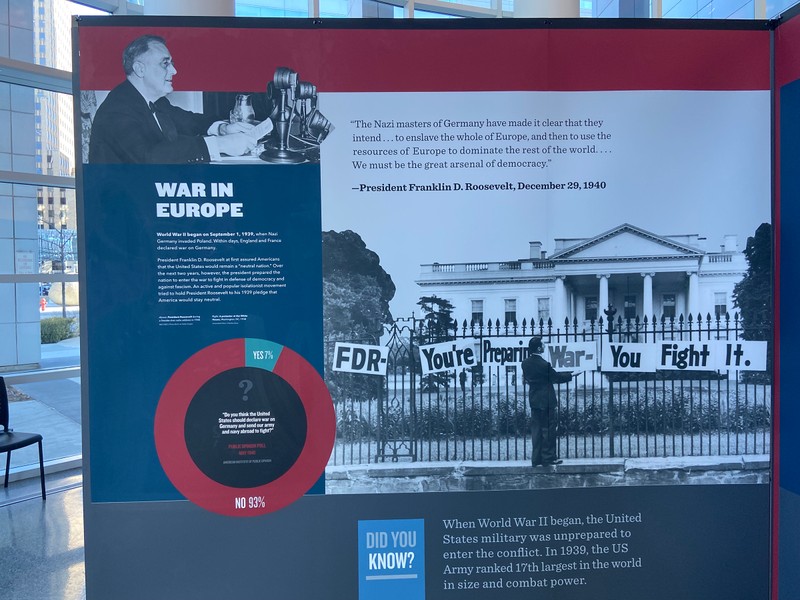War in Europe (Americans and the Holocaust)
Introduction
Author-Uploaded Audio
War in Europe (Americans and the Holocaust)
Text-to-speech Audio
The third section of the exhibition asks why did Americans go to war? It looks at the debates Americans were having about whether we should get involved, and what the war was about.
After Nazi Germany invaded Poland in September 1939, Great Britain and France declared war on Germany, officially starting World War II. At that time, President Franklin Roosevelt declared that the United States would remain neutral. If you want to come back and explore more after this tour, there is a short film on this kiosk that shows Roosevelt’s actions between 1939 and 1941—how he went from declaring that the United States would stay neutral, to getting the country prepared to enter the war to support Great Britain. Most Americans did not want to get involved in a foreign war, and as you can see in this “Did you Know” section, the country wasn’t ready to fight. When World War II began, the United States had the seventeenth largest Army in the world.
Images
War in Europe panel (Americans and the Holocaust)

Backstory and Context
Text-to-speech Audio
Metropolitan Library System is one of 50 U.S. libraries selected to host AMERICANS AND THE HOLOCAUST, a traveling exhibition from the U.S. Holocaust Memorial Museum that examines the motives, pressures, and fears that shaped Americans’ responses to Nazism, war, and genocide in Europe during the 1930s and 1940s.
The Americans and the Holocaust exhibit will be on display at the Downtown Library, along with a series of related special events from Thursday, January 5 to Sunday, February 12.
Based on extensive new research of that period, Americans and the Holocaust addresses important themes in American history, exploring the many factors — including the Great Depression, isolationism, xenophobia, racism, and antisemitism — that influenced decisions made by the U.S. government, the news media, organizations and individuals as they responded to Nazism. This exhibition will challenge the commonly held assumptions that Americans knew little and did nothing about the Nazi persecution and murder of Jews as the Holocaust unfolded.
Drawing on a remarkable collection of primary sources from the 1930s and ’40s, the exhibition focuses on the stories of individuals and groups of Americans who took action in response to Nazism. It will challenge visitors to consider the responsibilities and obstacles faced by individuals — from Franklin Delano Roosevelt to ordinary Americans — who made difficult choices, sought to effect change, and, in a few cases, took significant risks to help victims of Nazism even as rescue never became a government priority.
Americans and the Holocaust was made possible by the generous support of lead sponsor Jeannie & Jonathan Lavine. Additional major funding was provided by the Bildners — Joan & Allen z”l, Elisa Spungen & Rob, Nancy & Jim; and Jane and Daniel Och. The Museum's exhibitions are also supported by the Lester Robbins and Sheila Johnson Robbins Traveling and Special Exhibitions Fund, established in 1990.
Sources
United States Holocaust Memorial Museum. Accessed January 5th, 2023. https://www.ushmm.org/.
American Library Association. Accessed January 5th, 2023. https://www.ala.org/.
